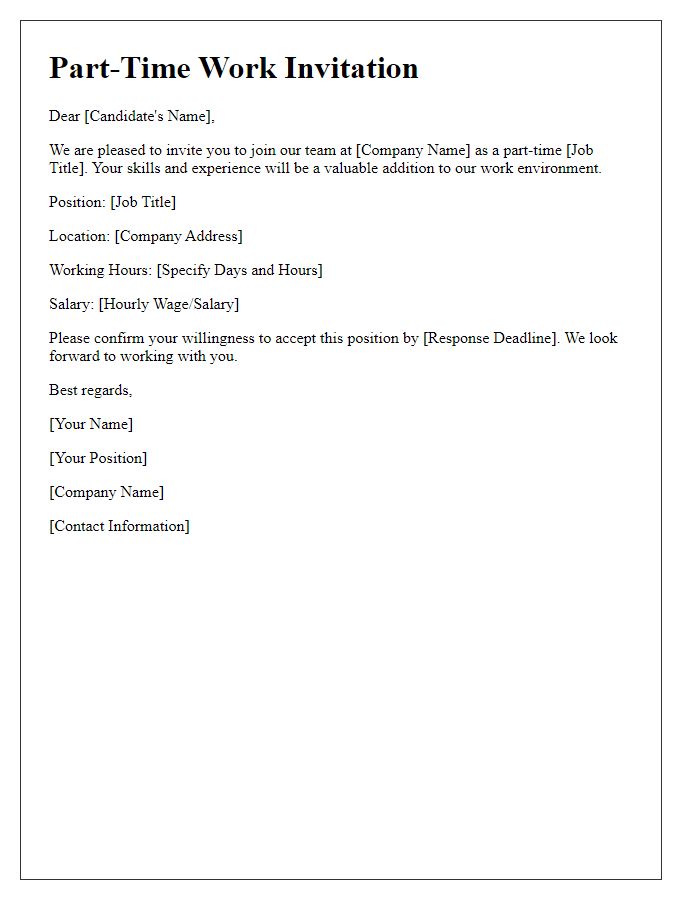Are you on the hunt for the perfect part-time job? Whether you're looking to gain experience in a new field or simply want some extra cash, finding the right opportunity can be a game-changer. With the right approach, crafting a compelling letter can set you apart from the competition. Stick around as we explore effective templates and tips to help you land that ideal part-time position!

Job Title and Position Details
A part-time job offer for the position of Customer Service Associate at XYZ Retail Company includes essential responsibilities such as assisting customers during high-volume shopping periods typically occurring during weekends and holidays. The role demands exceptional communication skills and a friendly demeanor to positively impact customer experience. The position offers flexible scheduling, with shifts ranging between 15 to 25 hours per week, accommodating both day and evening availability. Compensation includes an hourly wage of $15, plus potential bonuses during peak seasons like Black Friday or Christmas for outstanding performance. Applicants must demonstrate a commitment to upholding the company's values and policies while contributing to a positive team environment.
Work Schedule and Hours
A part-time job offer typically includes essential details about the work schedule and hours, providing clarity for prospective employees. The job, often in sectors like retail, hospitality, or administrative support, may require flexible hours, typically ranging from 10 to 30 hours per week. Shifts can vary, with positions potentially involving evenings or weekends, aligning with peak business hours. It is important to outline specific days and times employees are expected to work--for example, Wednesday to Sunday from 4 PM to 9 PM. This clear communication helps potential employees assess how the role fits within their existing commitments, ensuring a mutual understanding of availability and expectations. Detailed notes: - Part-time job positions often appeal to students or individuals seeking supplementary income. - Sectors such as retail and hospitality frequently offer flexible schedules to accommodate employee needs. - Clarification of shift times helps in planning and managing work-life balance effectively.
Compensation and Benefits
Part-time job offers often feature specific compensation structures, including hourly wages that typically range between $12 to $25 depending on the industry and geographical location, such as urban centers where living costs are higher. Benefits for part-time employees may vary significantly by company, sometimes including prorated paid time off, health insurance options, and flexible work arrangements designed to accommodate students or individuals balancing multiple jobs. Other incentives can include employee discounts, retirement plan access like 401(k), and performance bonuses based on achievements, which foster a motivated workforce. Such offers generally emphasize the importance of transparent communication regarding the details of compensation and any additional perks to ensure candidates feel valued and informed.
Responsibilities and Duties
The role of a part-time employee often involves various responsibilities crucial to the operational success of a business. Typical duties may include customer service, such as engaging with clients at retail spaces like Walmart or Target, ensuring a positive shopping experience. Administrative tasks could involve handling inventory management, requiring precise attention to detail to track stock levels and product organization. Additionally, employees may be responsible for maintaining cleanliness in workspaces, particularly in the food industry, where health regulations in establishments like McDonald's dictate strict hygiene standards. Team collaboration is essential, especially during busy periods, allowing for efficient service and workflow. Time management skills are also crucial, as fulfilling shifts promptly can significantly influence the productivity and overall effectiveness of the team.
Reporting Structure and Team Integration
The reporting structure within the organization defines the hierarchy and flow of communication essential for effective teamwork and collaboration. In this dynamic environment, new hires will integrate into diverse teams, fostering camaraderie and innovation. Regular meetings, typically held weekly, will allow feedback sharing and alignment on goals. Each team consists of five to seven members, ensuring both individual contribution and collective accountability. Team leaders, often with extensive industry experience, will guide daily operations and strategic initiatives. A robust onboarding program facilitates seamless integration, introducing new employees to company culture, tools, and key stakeholders. Regular training sessions and mentorship opportunities further support personal and professional development within the team framework.













Comments